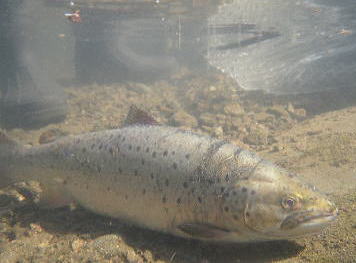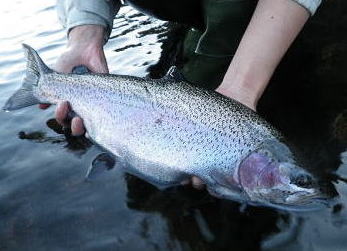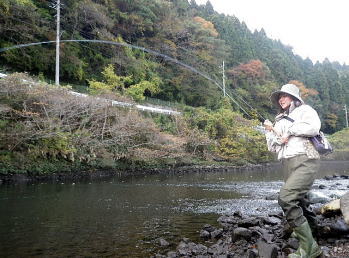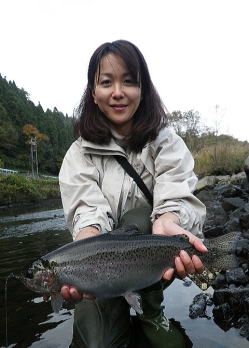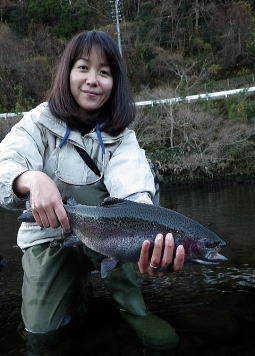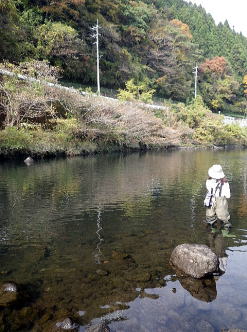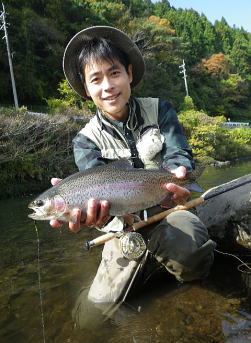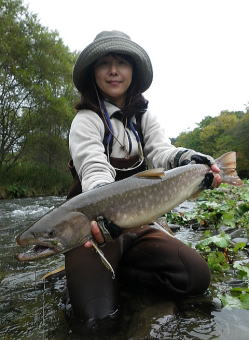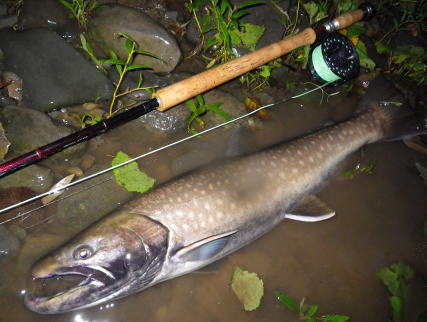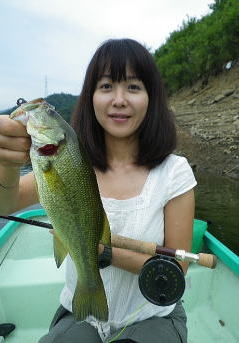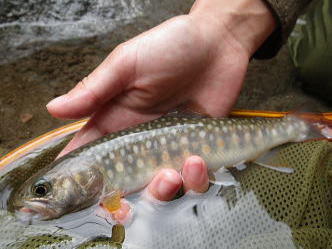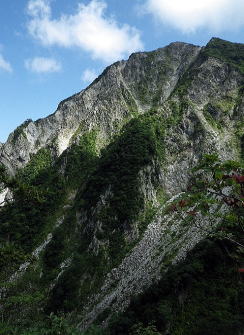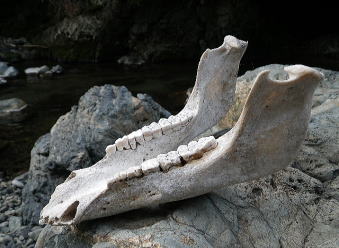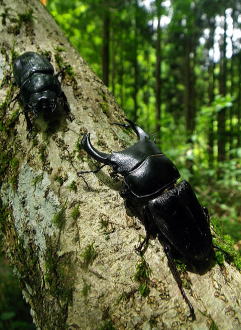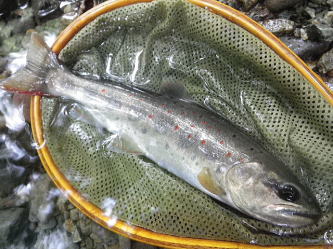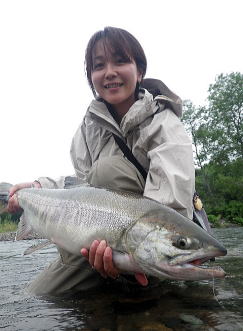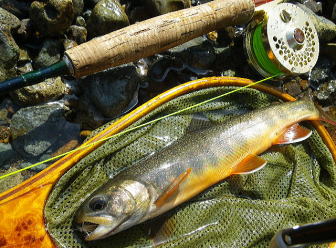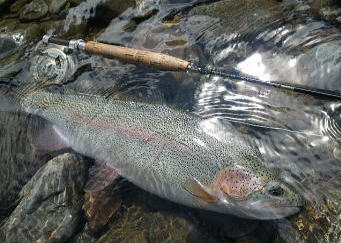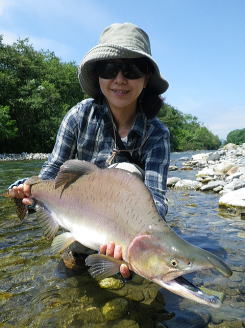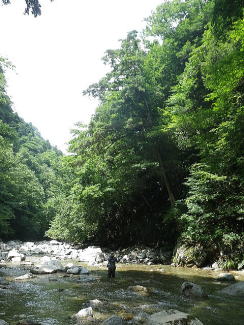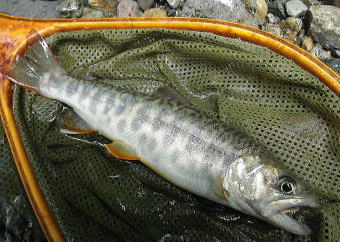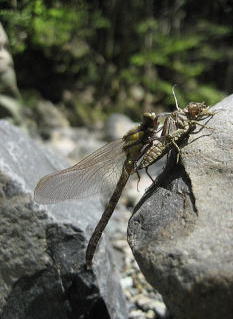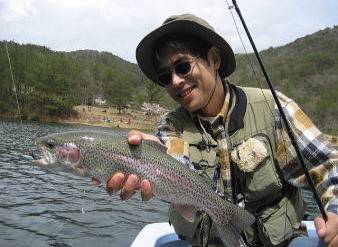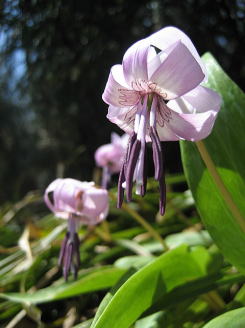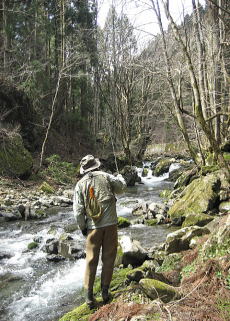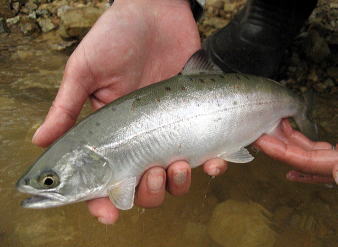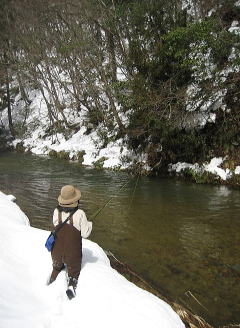Even more amazing was the existence of brown trout. This fish was captured by our angling friend on the same day.
Yes, to be continued!!
- Saltwater
Another chunky silver bullet with a solid thick body. A monumental discovery
in otherwise not too exciting fishing scenes in west Japan.
A solid rainbow with a girth of 28cms.
Utterly convinced this was not a fluke, we must come back here again next
year.
Sayuri was quick enough to underwrite my conviction. The nicely bent rod
says it all.
To our surprise, our arrival was greeted by many suspicious dimple rises.
And it didn't take long for Sayuri to be attached to a nice Satsukimasu,
a sea(lake)-run strain of Amego trout.
December
3 weeks after the newly discovered hot spot made me somewhat uneasy. Gotta
go back and check it again!
Fishing was slow but Sayuri in the end pulled out yet another silver torpedo!
The olive woolly bugger I drifted slowly in the current was snatched by
a nice chunky rainbow.
Not all rumours are unfounded fishermen's tale!!
November
A man made reservoir in the middle of Chugoku mountains where rumours of
big trout were heard. Lured by the temptation we had made two weekend visits
with not a single bite. Our expectation was not running high on our 3rd
visit either.
Another comely mountain, Mt. Oakan in its colourful autumn attire.
They are dirty fighters in a fast running water. Catching them on a light
tackle is a great sport.
October
Visited N.E. Hokkaido again, this time in pursuit of sea run Amemasu char.
October
Teasing those little largemouths on a surface bug imitations is a carefree
sport.
Couldn't catch any trophies but a fun fishing in the pristine streams.
September
A weekend trip to Mt. Daisen. At 1,709m above sea, it is the tallest mountain
in the Chugoku region worshipped as a sacred place.
Yet another evidence - a lower jaw of a wildboar.
Though the mountains in Hiroshima have only modest elevations, thanks to
the westerly winds that bring rich rainfall, the forests remain green and
lush, supporting vibrant ecosystem.
End Aug.
Hiroshima's streams close on Aug. 31.
She is a lucky fish that survived the season's ordeal. Now do rest, till
spring.
A glamorous hen salmon in Churui river.
Early season salmon provides a first class sport.
Hidden in the upper most reaches of mountain streams are small yet beautiful
native char of Hokkaido, Osshorokoma.
Obon holidays
Two weeks in cool Hokkaido away from the scorching heat of the mainland.
Tottabetsu river in the central Hokkaido is a home to big wild rainbows,
as well as even bigger Grizzly bears.
Pink salmon runs up rivers from mid August to late September. Not a hardest
fighting salmon I must admit but impressive to look at.
Aug. 1
A popular excursion spot for Hiroshimaites - Sandankyo in the high summer.
Rising water level is a definitive key to a success. Here, my third bass
beyond the magic 50cm mark.
July 11
The monsoon rain filled up the lakes, calling us to join the lurefishermen
for their hunt for trophy largemouth bass.
Lured by the hatching mayflies, these normally elusive Amemasu char come
into lake Akan's shallow margins - an opportunity not for us Japanese flyfishers
should miss out.
And sure enough, the nearby stream produced a very handsome Amego to kick
start the dry fly season.
July 19
An unusual catch - cross between Amego trout and Gogi char.
May
The riverside gets busier day by day
with numerous new lives joining the drama.
April 10
Lake Takamiya, one of Hiroshima's few Pay'n fish reservoir provides fine
entertainment this time of the year.
April 3
A popular fishery Ogawagawa. Its elevation delays the turn of the seasons,
but the sturdy gogi char are already awake grabbing at any well presented
nymphs.
June
A weekend trip to Akanko, in the north east of Hokkaido.
April 25
Flowers of Katakuri announce the late advent of spring in the high country.
May 22
Hijiriko lake is a home to Satsukimasu, a sea run strain of Amego trout.
Though these are unfortunately landlocked and grow only to 40cm max.
May 13
Mountains in the north of Hiroshima are still buried in 2 feet of snow.
Not much action in the ice cold water yet.
 '10 Freshwater
'10 Freshwater